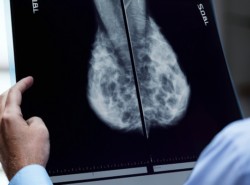
A study of twins and sisters for predicting breast cancer risk from mammograms
Published: 04/30/24 8:24 AM

John Hopper
Project Description:
Prof John Hopper at the University of Melbourne has been working in the BRAIx program, with partners St Vincent’s Institute of Medical Research, BreastScreen Victoria, St Vincent’s Hospital Melbourne, and the Australian Institute of Machine Learning at the University of Adelaide, that is jointly developing AI models to improve breast cancer screening. Prof Hopper and colleagues have recently discovered a new mammogram-based measure of breast cancer risk (BRAIx risk score) that can predict the risk of developing breast cancer better than all known genetic factors.
With the support of the National Breast Cancer Foundation, a new research project is examining novel methods to investigate the genetic and lifestyle factors contributing to the BRAIx risk score, aiming to uncover fresh insights into the causes of breast cancer. Digital mammograms, blood samples and personal information will be collected from pairs of twins and sisters with and without breast cancer. These findings could potentially lead to ways to lower the risk of breast cancer and identify women and their families at high risk.
Professor Hopper is a Chief Investigator on A Study of Twins and Sisters for Predicting Breast Cancer Risk from Mammograms, along with a global team of researchers from the University of Melbourne, Monash University, BreastScreen South Australia, Cancer Council Victoria, Seoul National University, Monash University Malaysia, and Industrial University of Santander.
Why is this work needed:
While breast screening mammograms have been a standard practice in Australia and the effectiveness is evident in the reduction of breast cancer related deaths, screening protocols have remained largely unaltered. Improving breast cancer screening by identifying the women most at risk of breast cancer, automatically at the time of their mammograms, could achieve better survival outcomes and further reduce deaths from this disease.
Expected outcomes:
Successful outcomes of this study will reveal new breast cancer risk factors and how a combination of these factors contribute to the mammogram-based measure of breast cancer risk. Implementation into population breast screening could help identify women at substantial risk of the disease not previously recognised.
Project description:
Mammograms contain information that can predict breast cancer risk. Prior research by Prof John Hopper at the University at Melbourne in the BRAIx program, with partners St Vincent’s Institute of Medical Research, BreastScreen Victoria, St Vincent’s Hospital Melbourne, and the Australian Institute of Machine Learning at the University of Adelaide, led to a breakthrough in breast cancer risk prediction. The team discovered that specific features on a digital mammogram, when read by AI models, generate a novel risk score (BRAIx Risk Score) that predicts breast cancer risk better than all known genetic factors.
With NBCF support the new research project will collect digital mammograms, blood samples and personal information (family history, lifestyle) from 1,000 twins and sisters whom they have previously studied, and from a further 1,000 twins without breast cancer, and an additional 100 pairs twins affected by breast cancer. The twin family study design can provide information about both genetic and non-genetic factors. Using state of the art technologies the team will investigate the genetic and lifestyle-related factors that underly BRAIx Risk Score and determine if and how these factors cause breast cancer.
Using innovative approaches this study will produce new findings about what causes breast cancer and how to improve screening and lower breast cancer mortality.
More Research Projects
View all research